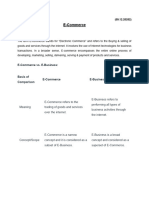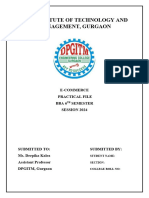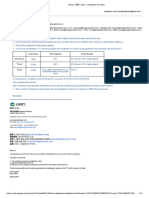0% found this document useful (0 votes)
17 views3 pagesE-Commerce Notes Expanded
The document outlines key concepts in e-commerce, including social commerce, the role of technology, and the differences between personalization and customization. It discusses various e-commerce models such as B2B, B2C, C2C, and G2C, along with the effectiveness of online advertising and the benefits of cloud computing. Additionally, it addresses cyber challenges in e-business and measures to enhance security.
Uploaded by
Sana KhanCopyright
© © All Rights Reserved
We take content rights seriously. If you suspect this is your content, claim it here.
Available Formats
Download as DOCX, PDF, TXT or read online on Scribd
0% found this document useful (0 votes)
17 views3 pagesE-Commerce Notes Expanded
The document outlines key concepts in e-commerce, including social commerce, the role of technology, and the differences between personalization and customization. It discusses various e-commerce models such as B2B, B2C, C2C, and G2C, along with the effectiveness of online advertising and the benefits of cloud computing. Additionally, it addresses cyber challenges in e-business and measures to enhance security.
Uploaded by
Sana KhanCopyright
© © All Rights Reserved
We take content rights seriously. If you suspect this is your content, claim it here.
Available Formats
Download as DOCX, PDF, TXT or read online on Scribd
/ 3























































































